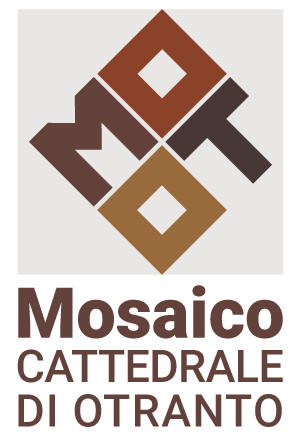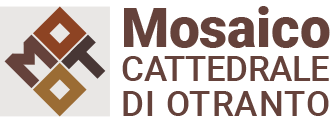Pantaleone the artist
Author of a Medieval visual encyclopaedia
No documentary records have survived about the man behind the Otranto mosaic, but the four Latin inscriptions within its tiles do reveal his name: Pantaleone.
The first legible inscription, located at the entrance to the cathedral, gives us two names: Gionata, the man who commissioned the mosaic, or rather, the archbishop presiding over the Archdiocese of Otranto during the time that the mosaic was built, and Pantaleone, the skilful architect of the great Otranto Mosaic.
But who was Pantaleone?
Pantaleone was almost certainly a presbyter (a high-ranking priest), as this is how he signed the inscriptions.
His name is usually linked to the Abbey of St Nicholas in Casole, an important Basilian coenobitic monastery for religious and contemplative life located only a few kilometres away from Otranto near Punta Palascìa and which was destroyed by the Ottomans in 1480, leaving only a handful of ruins that survive to the present day.
We do not know for certain if Pantaleone was a monk at the monastery.
The extraordinary level of culture that can be seen in the filigree of his mosaic masterpiece does suggest however that Pantaleone knew and frequented the Abbey of St Nicholas in Casole, which at the time was an important University in the Western world.
The Casulan Library
The abbey possessed an extraordinary library, filled with important volumes, where the scribes transcribed, copied and illuminated Latin and Ancient Greek parchment codices, many of which came through Otranto.
This meant that the monastery’s library was constantly being enriched and added to with texts from all over the known world.
Thanks to its strategic position in the heart of the Mediterranean, during the Middle Ages Otranto was a major trading and commercial port, as well as an important junction between the Eastern and Western worlds.
The Abbey of St Nicholas in Casole was a kind of study residence, where philosophy, rhetoric and astronomy were studied and texts, both sacred and secular, were translated from Latin, Greek, Hebrew and Aramaic.
A frequent visitor to the richly packed library
Although the Basilian monastery at Casole was destroyed in 1480, most of its manuscripts were saved thanks to the efforts of a certain Cardinal Besarione, an extraordinarily cultured man whose collection of many different works helped to preserve an immense amount of Byzantine cultural heritage. Today the Casulan codices are kept in the very best libraries in Italy and the rest of Europe.
Among these is the Casulan Typikon, an exquisitely illuminated manuscript that gives us a valuable insight into how religious and contemplative life took place in the Abbey based on the Benedictine motto of Ora et labora (Pray and work). The day of the average monk at the Casole monastery was focused on activity and prayer: prayer sanctified work, and work became prayer.
If he was not a presbyter at the abbey itself, Pantaleone was certainly a frequent visitor to its exquisitely stocked library, as revealed by the level of culture displayed in his work.
A deep knowledge of scripture
In 1163 Bishop Jonathas commissioned Pantaleone to produce a large floor mosaic for the new cathedral; built only a few years earlier in the centre of Otranto, which was to depict the story of the History of Salvation.
As a man of the Church, Pantaleone would have had an intimate knowledge of holy texts.
The library at Casole would not only have given him the opportunity to read texts in the classical Latin tradition, but also a wealth of texts in the Byzantine tradition, the products of two great civilisations inextricably linked by centuries-old ties.
Without a doubt he would have studied the Physiologus, an encyclopaedia-like manuscript written in Ancient Greek that was most likely written in Alexandria during the early part of the Christian era. Its contents and illuminations were spread across the Mediterranean and would have been widely known from the 5th century AD onwards thanks to translations into Armenian, Ethiopic (Ge’ez), Syriac and Latin.
He would have also possessed Medieval bestiaries and herbaria, true encyclopaedias in which allegorical interpretations and religious properties were attributed to various types of plants, animals and stones.
As a man of his time, Pantaleone would have had a deep knowledge of myths and legends, many versions of which would have been circulating during his lifetime.
Above all else, Pantaleone would have been extremely well versed in the subject he was asked to depict in his mosaic: the History of Salvation, which is the human history of sin and the divine history of the renewed covenant.
What other churches and cathedrals told using wall frescoes, Otranto did on its floor, a “story-telling floor” that calls to mind the Way that accompanies and guides Man along the path to Salvation.
Thus, with 600,000 pieces of coloured pietra dura tiles, Pantaleone composed a large stone book, defined by many as a “Medieval visual encyclopaedia”


